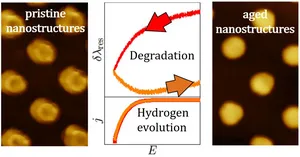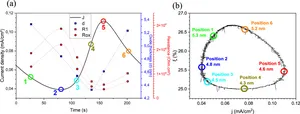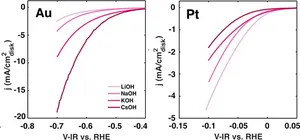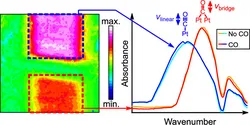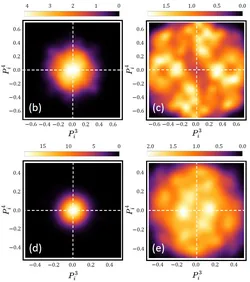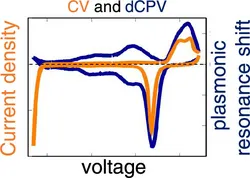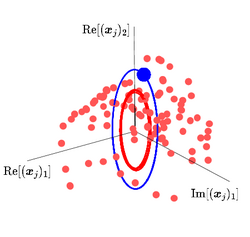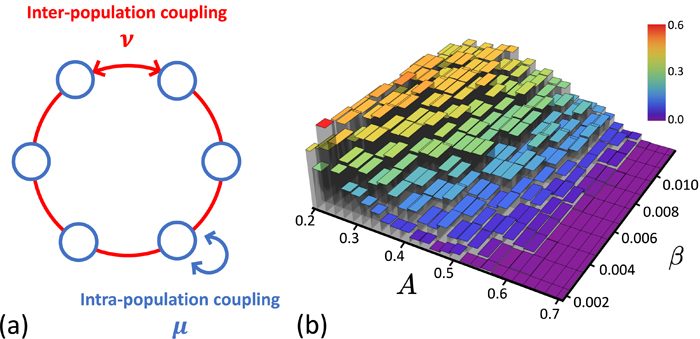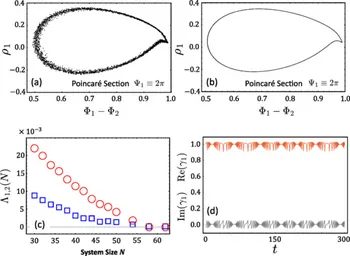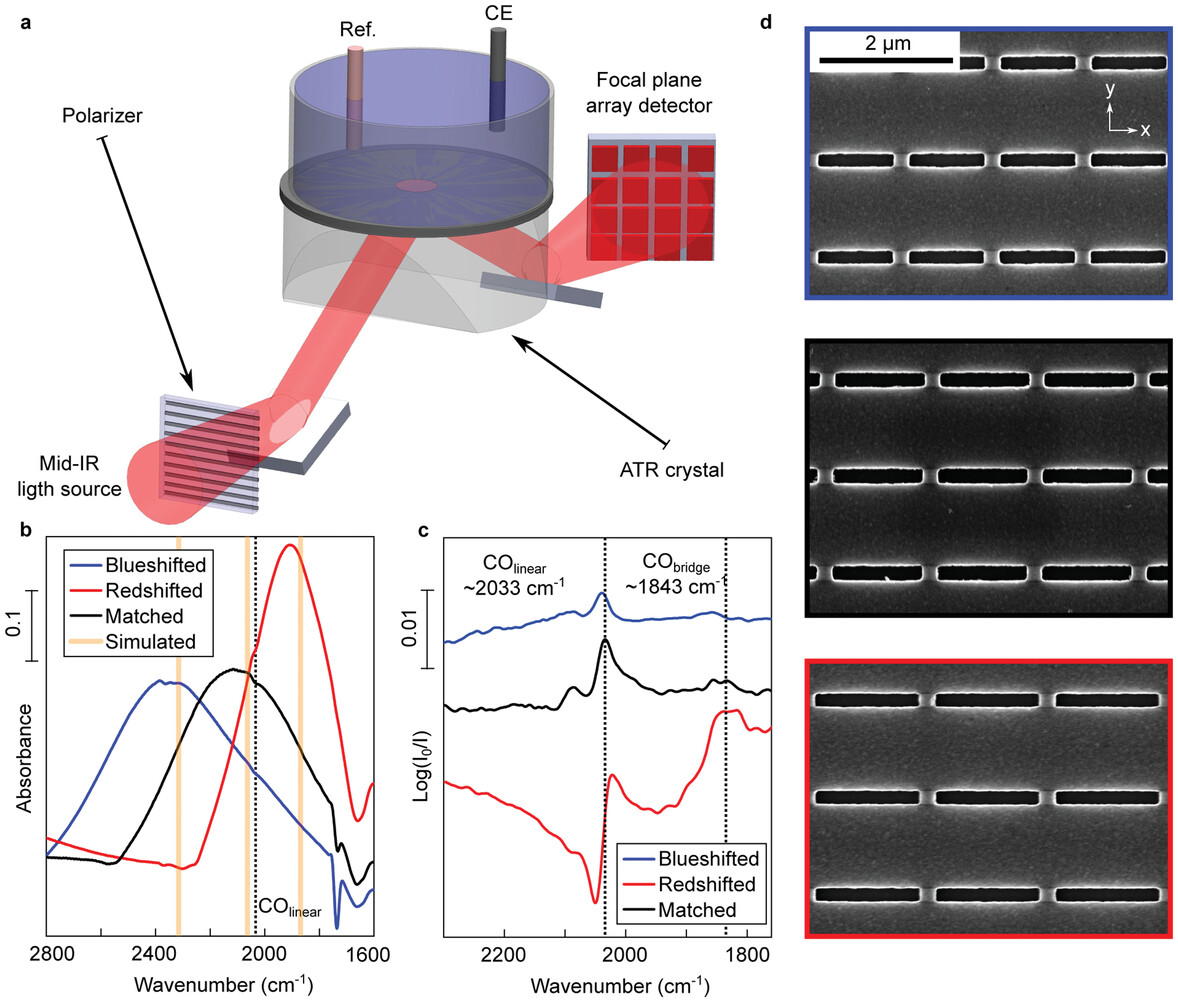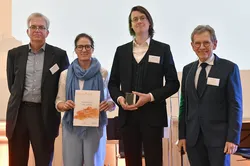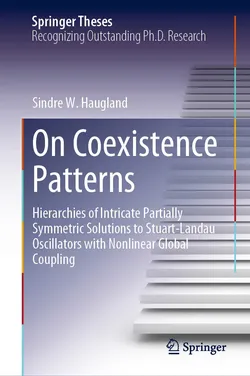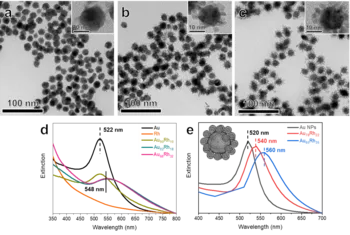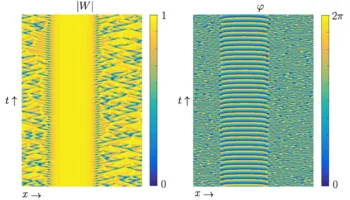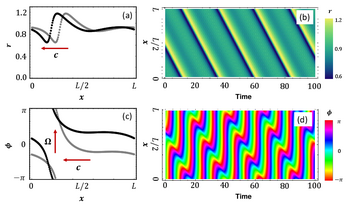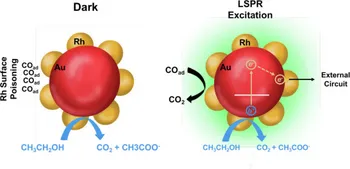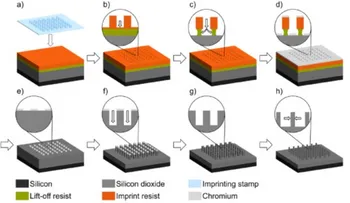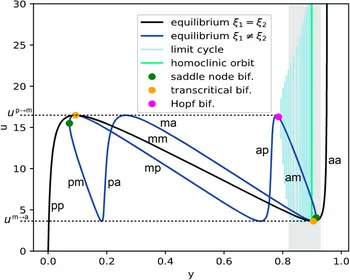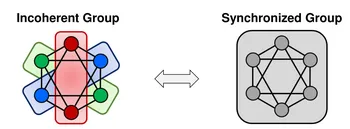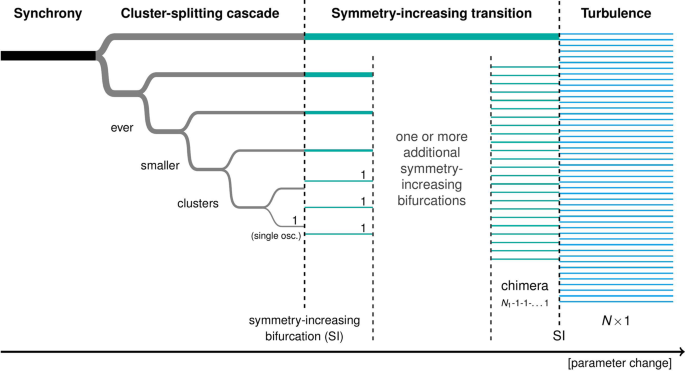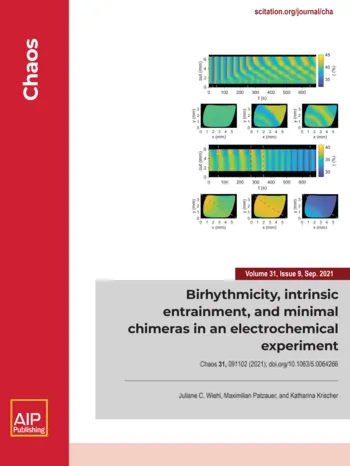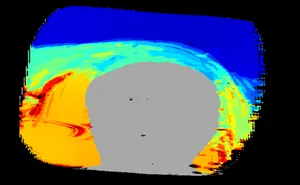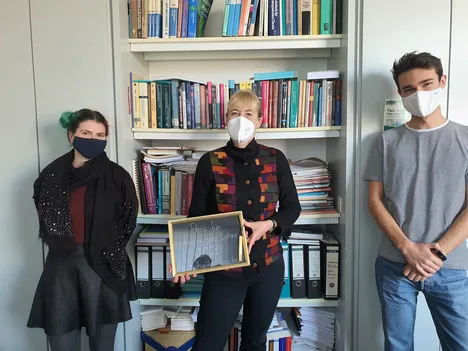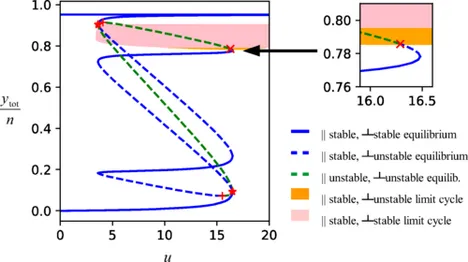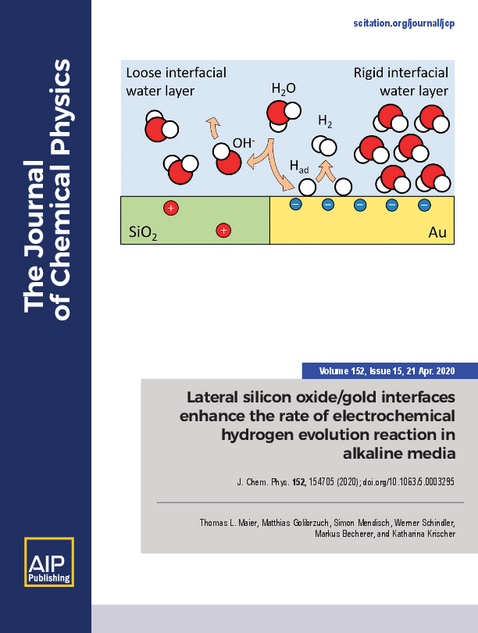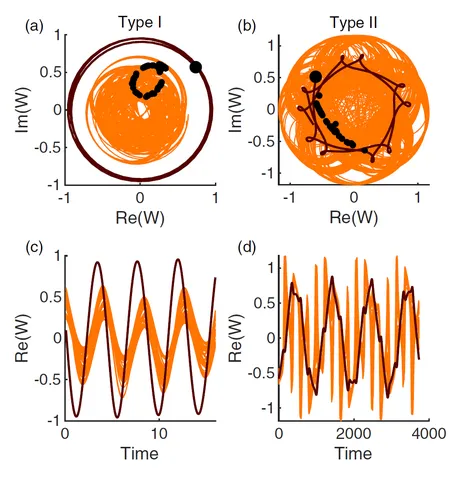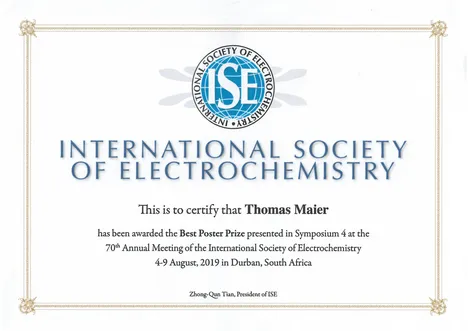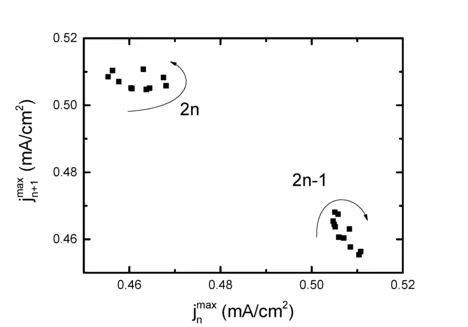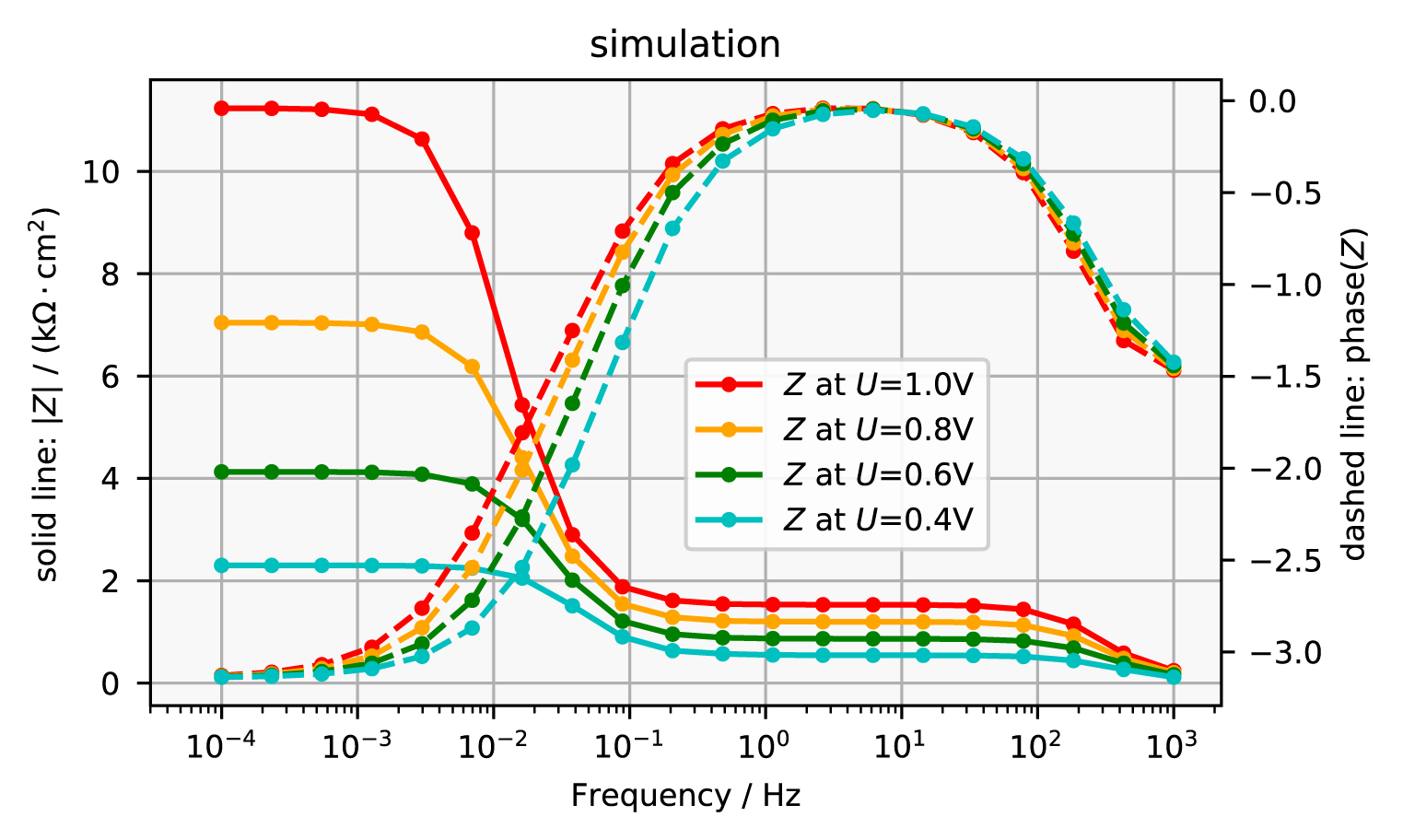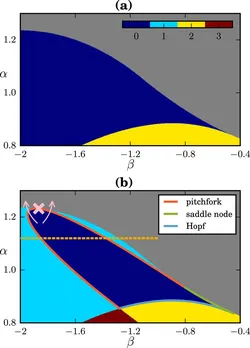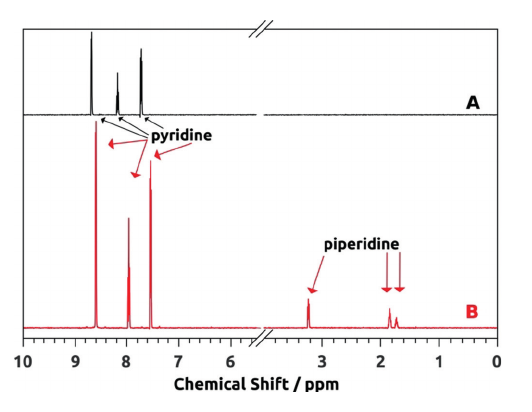March 2025
Stability of the Au/electrolyte interface during hydrogen evolution: A Cyclic Plasmo-Voltammetry study
Metal-electrolyte interfaces are dynamic entities, the potential and electrolyte dependent mobility of the metal atoms leading to surface restructuring with possible dissolution and degradation. In this work, we investigate the stability of the Au/aqueous electrolyte interface with in situ differential Cyclic Plasmo-Voltammetry (dCPV), augmented by ex situ atomic force microscopy and finite differential time domain simulations. We demonstrate that even the onset of hydrogen evolution is accompanied by pronounced morphological changes of the interface which are by far more prominent than those occurring during Au oxidation and reduction. …
For the full article, see here.
August 2024
-
Application of the Point Defect Model to the Oscillatory Anodic Oxidation of Illuminated n-Type Silicon in the Presence of Fluoride Ions Using Electrochemical Impedance Spectroscopy
This work aims to provide insight into the oscillations occurring during the anodic electrooxidation of Si in fluoride-containing electrolytes using electrochemical impedance spectroscopy (EIS). The EIS measurements were conducted within less than a tenth of the oscillation periods allowing changes in the electrical properties of the silicon/oxide/electrolyte interfaces to be monitored during an oscillatory cycle. Application of the power law model to the experimental data revealed a significant change in resistivity at the oxide/semiconductor interface while ...
For the full article, see here.
July 2024
-
Electrolyte effects on the alkaline hydrogen evolution reaction: A mean-field approach
This paper introduces the combination of an advanced double-layer model with electrochemical kinetics to explain electrolyte effects on the alkaline hydrogen evolution reaction. It is known from experimental studies that the alkaline hydrogen evolution current shows a strong dependence on the concentration and identity of cations in the electrolyte, but is independent of pH. To explain these effects, we formulate the faradaic current in terms of the electric potential in the double layer, which is calculated using a mean-field model that takes into account ...
For the full article, see here.
-
How Metal/Insulator Interfaces Enable an Enhancement of the Hydrogen Evolution Reaction Kinetics
The nanostructuring of electrodes is a common way of increasing electrocatalytic activity. Yet, the fact that the presence of insulating material in nanostructured composites can have a positive effect on efficiency was an unexpected recent finding. The rate enhancement has been linked to different electric fields at the insulator and metal interfaces, facilitating enhanced transport of reaction products into the bulk electrolyte. In this article, we further uncover the origin of the rate enhancement with parameter studies and simulations. We experimentally investigate various parameter ...
For the full article, see here.
February 2024
-
Multi-band Metasurface-Driven Surface-Enhanced Infrared Absorption Spectroscopy for Improved Characterization of in-Situ Electrochemical Reactions
Surface-enhanced spectroscopy techniques are the method-of-choice to characterize adsorbed intermediates occurring during electrochemical reactions, which are crucial in realizing a green and sustainable future. Characterizing species with low coverage or short lifetimes has so far been limited by low signal enhancement. Recently, single-band metasurface-driven surface-enhanced infrared absorption spectroscopy (SEIRAS) has been pioneered as a promising technology to monitor a single vibrational mode during electrochemical CO oxidation. However,...
For the full article, see here.
-
Volcano transition in a system of generalized Kuramoto oscillators with random frustrated interactions
In a system of heterogeneous (Abelian) Kuramoto oscillators with random or 'frustrated' interactions, transitions from states of incoherence to partial synchronization were observed. These so-called volcano transitions are characterized by a change in the shape of a local field distribution and were discussed in connection with an oscillator glass. In this paper, we consider a different class of oscillators, namely a system of (non-Abelian) SU(2)-Lohe oscillators that can also be defined on the 3-sphere, i.e. an oscillator is generalized to be defined as a unit vector in four-dimensional Euclidean space. We demonstrate that such higher-dimensional Kuramoto models with reciprocal and nonreciprocal random interactions represented by a low-rank matrix exhibit a volcano transition as well. ...
For the full article, see here.
September 2023
-
Characterization of Different Au/Electrolyte Interfaces via In Situ Differential Cyclic Plasmo-Voltammetry
In this article, we describe an improved method that uses in situ plasmonic spectroscopy to reliably track changes of the metal–electrolyte interface over a large potential window. Utilizing the specific sensitivity of the plasmonic resonance toward changes in the interfacial properties of nanoparticles (NPs), processes such as double-layer charging, surface oxidation/reduction, adsorption and desorption of anions, as well as metal under- and overpotential deposition are resolved. The main contributions to this signal are changes in the charge of the NPs and chemical interface damping due to ...
For the full article, see here.
August 2023
-
Chimera dynamics of generalized Kuramoto-Sakaguchi oscillators in two-population networks
Chimera dynamics, an intriguing phenomenon of coupled oscillators, is characterized by the coexistence of coherence and incoherence, arising from a symmetrybreaking mechanism. Extensive research has been performed in various systems, focusing on a system of Kuramoto-Sakaguchi (KS) phase oscillators. In recent developments, the system has been extended to the so-called generalized Kuramoto model, wherein an oscillator is situated on the surface of an M-dimensional unit sphere, rather than being confined to a unit circle. In this paper, we exploit the model introduced in ...
For the full article, see here.
June 2023
-
Heteroclinic switching between chimeras in a ring of six oscillator populations
In a network of coupled oscillators, a symmetry-broken dynamical state characterized by the coexistence of coherent and incoherent parts can spontaneously form. It is known as a chimera state. We study chimera states in a network consisting of six populations of identical Kuramoto–Sakaguchi phase oscillators. The populations are arranged in a ring, and oscillators belonging to one population are uniformly coupled to all oscillators within the same population and to those in the two neighboring populations. This topology supports the existence of different configurations of coherent and incoherent ...
For the publishers version of the full article, see here.
May 2023
-
Chaotic chimera attractors in a triangular network of identical oscillators
A prominent type of collective dynamics in networks of coupled oscillators is the coexistence of coherently and incoherently oscillating domains known as chimera states. Chimera states exhibit various macroscopic dynamics with different motions of the Kuramoto order parameter. Stationary, periodic and quasiperiodic chimeras are known to occur in two-population networks of identical phase oscillators. In a three-population network of identical Kuramoto-Sakaguchi phase oscillators, stationary and periodic symmetric chimeras were previously studied on a reduced manifold in which two populations ...
For the publishers version of the full article, see here.
April 2023
-
Improved In Situ Characterization of Electrochemical Interfaces Using Metasurface-Driven Surface-Enhanced IR Absorption Spectroscopy
Electrocatalysis plays a crucial role in realizing the transition toward a zero-carbon future, driving research directions from green hydrogen generation to carbon dioxide reduction. Surface-enhanced infrared absorption spectroscopy (SEIRAS) is a suitable method for investigating electrocatalytic processes because it can monitor with chemical specificity the mechanisms of the reactions. However, it remains difficult to detect many relevant aspects of electrochemical reactions such as short-lived intermediates. Herein, an integrated nanophotonic-electrochemical SEIRAS platform is developed and ...
For the publishers version of the full article, see here.
March 2023
-
LeLa-Preis 2023 für das Experiment des Jahres
We are happy and proud to report that Moritz Feil, who is a member of School laboratory e-conversion (Garching) has been awarded this years LeLa Prize by LernortLabor - Bundesverband der Schülerlabor
-
On Coexistence Patterns - Hierarchies of Intricate Partially Symmetric Solutions to Stuart-Landau Oscillators with Nonlinear Global Coupling
We are happy to announce that Dr. Sindre W. Haugland's Ph.D. thesis was published in the Springer Theses -Recognizing Outstanding Ph.D. Research.
This book is about coexistence patterns in ensembles of globally coupled nonlinear oscillators. Coexistence patterns in this respect are states of a dynamical system in which the dynamics in some parts of the system differ significantly from those in other parts, even though there is no underlying structural difference between the different parts. In other words, these asymmetric patterns emerge in a self-organized manner. ...
For the publishers version of the book, see here.
January 2023
-
Gold–Rhodium Nanoflowers for the Plasmon-Enhanced CO2 Electroreduction Reaction upon Visible Light
Bimetallic nanostructures combining catalytic and plasmonic properties are a class of materials that might possess improved efficiency and/or selectivity in electrocatalytic reactions. In this paper, we described the application of gold–rhodium core–shell nanoflowers (Au@Rh NFs) as a model system for the electrochemical CO2 reduction reaction. The nanoparticles consist of a gold nucleus surrounded by rhodium branches, combining Au localized surface plasmon resonance (LSPR) in the visible range of the spectrum and Rh catalytic properties. The influence of LSPR excitation on the catalytic ...
For the publishers version of the full article, see here.
October 2022
-
Chimera states under genuine local coupling
Chimera states, important forms of spatiotemporal self-organization in ensembles of identical oscillators, have been found in a wide variety of systems, provided that the coupling between the oscillators was nonlocal or global. Therefore, it is generally assumed that a locally coupled oscillatory medium, as described by the complex Ginzburg–Landau equation (CGLE), does not support chimera states. Here we show an alternative mechanism that does indeed lead to chimera states in a purely locally-coupled system, namely the interaction of an oscillatory medium, in the present case the CGLE, with a bistable internal degree of freedom.
For the publishers version of the full article, see here.
-
Nontrivial twisted states in nonlocally coupled Stuart-Landau oscillators
A twisted state is an important yet simple form of collective dynamics in an oscillatory medium. Here we describe a nontrivial type of twisted state in a system of nonlocally coupled Stuart-Landau oscillators. The nontrivial twisted state (NTS) is a coherent traveling wave characterized by inhomogeneous profiles of amplitudes and phase gradients, which can be assigned a winding number. To further investigate its properties, several methods are employed. We perform a linear stability analysis in the continuum limit and compare the results with Lyapunov exponents obtained in a finite-size system. ...
For the publishers version of the full article, see here.
May 2022
-
Gold–rhodium nanoflowers for the plasmon enhanced ethanol electrooxidation under visible light for tuning the activity and selectivity
Direct ethanol fuel cells (DEFCs) are a promising power source, but the low selectivity to ethanol complete oxidation is still challenging. The localized surface plasmon resonance (LSPR) excitation has been reported to accelerate and drive several chemical reactions, including the ethanol oxidation reaction (EOR), coming as a strategy to improve catalysts performance. Nonetheless, metallic nanoparticles (NPs) that present the LSPR excitation in the visible range are known for leading to the incomplete oxidation of ethanol. Thus, we report here the application of gold-rhodium ...
For the publishers version of the full article, see here.
April 2022
-
Tuning the feature size of nanoimprinting stamps: A method to enhance the flexibility of nanoimprint lithography
In the field of nanoimprinting lithography, fabricating large-area imprinting stamps is often the most time- and resource-consuming step. Specifically in research, it is often not reasonable to produce a new imprinting stamp for each new experimental configuration. Therefore, the lack of flexibility in feature sizes makes prototyping and tailoring the feature sizes according to their application challenging. To overcome these restrictions, we developed an imprinting stamp reproduction and tuning method which enables the size of the features of existing imprinting stamps to be tuned within nanometer ...
For the publishers version of the full article, see here.
November 2021
-
Bifurcations of Clusters and Collective Oscillations in Networks of Bistable Units
We investigate dynamics and bifurcations in a mathematical model that captures electrochemical experiments on arrays of microelectrodes. In isolation, each individual microelectrode is described by a one-dimensional unit with a bistable current-potential response. When an array of such electrodes is coupled by controlling the total electric current, the common electric potential of all electrodes oscillates in some interval of the current. These coupling-induced collective oscillations of bistable one-dimensional units are captured by the model. Moreover, any equilibrium is contained in a cluster subspace, ...
For the publishers version of the full article, see here.
-
Attracting Poisson chimeras in two-population networks
Chimera states, i.e., dynamical states composed of coexisting synchronous and asynchronous oscillations, have been reported to exist in diverse topologies of oscillators in simulations and experiments. Two-population networks with distinct intra- and inter-population coupling have served as simple model systems for chimera states since they possess an invariant synchronized manifold in contrast to networks on a spatial structure. Here, we study dynamical and spectral properties of finite-sized chimeras on two-population networks. First, we elucidate how the Kuramoto order parameter of the finite-sized ...
For the publishers version of the full article, see here.
October 2021
- We are happy to announce that the following Nature Communications' article was featured as an Editors’ Highlights webpage of recent research called “Applied physics and mathematics.”
Between synchrony and turbulence: Intricate hierarchies of coexistence patterns
Coupled oscillators, even identical ones, display a wide range of behaviours, among them synchrony and incoherence. The 2002 discovery of so-called chimera states, states of coexisting synchronized and unsynchronized oscillators, provided a possible link between the two and definitely showed that different parts of the same ensemble can sustain qualitatively different forms of motion. Here, we demonstrate that globally coupled identical oscillators can express a range of coexistence patterns more comprehensive than chimeras. A hierarchy of such states evolves from the fully synchronized ...
For the publishers version of the full article, see here.
September 2021
Chaos Editor’s Pick and Cover Page of Chaos
- We are happy to announce that the following article was promoted as an Editor's Pick in Chaos: An Interdisciplinary Journal of Nonlinear Science. and chosen as its coverpage.
Birhythmicity, intrinsic entrainment, and minimal chimeras in an electrochemical experiment
The coexistence of limit cycles in phase space, so called birhythmicity, is a phenomenon known to exist in many systems 7 in various disciplines. Yet, detailed experimental investigations are rare, as are studies on the interaction between 8 birhythmic components. In this article, we present experimental evidence for the existence of birhythmicity during 9 the anodic electrodissolution of Si in a fluoride-containing electrolyte using weakly illuminated n-type Si electrodes. 10 Moreover, we demonstrate several types of interaction between the coexisting limit cycles, in part resulting in peculiar 11 ...
For the publishers version of the full article, see here.
For the postprint version of the full article, see here.
May 2021
PRL Editor's Suggestion
- We are happy to announce that the following article was selected to be a PRL Editor's Suggestion
Self-Organized Multifrequency Clusters in an Oscillating Electrochemical System withStrong Nonlinear Coupling
We study the spatiotemporal dynamics of the oscillatory photoelectrodissolution of n-type Si in a fluoride-containing electrolyte under anodic potentials using in situ ellipsometric imaging. When lowering the illumination intensity step wise, we successively observe uniform oscillations, modulated amplitude clusters, and the coexistence of multifrequency clusters, i.e., regions with different frequencies, with a stationary domain. We argue that the multifrequency clusters emerge due to an adaptive, nonlinear, and nonlocal coupling, similar to those found in the context of neural dynamics.
For the publishers version of the full article, see here.
November 2020
Golden Chalk Award
- We are happy and proud to report that Prof. Katharina Krischer has been awarded this years Golden Chalk for sustainably good teaching by the Fachschaft Mathematik, Physik und Informatik.
October 2020
- Collective oscillations of globally coupled bistable, nonresonant components
Bistable microelectrodes with an S-shaped current-voltage characteristic have recently been shown to oscillate under current control, when connected in parallel. In other systems with equivalently coupled bistable components, such oscillatory instabilities have not been reported. In this paper, we derive a general criterion for when an ensemble of coupled bistable components may become oscillatorily unstable. Using a general model, we perform a stability analysis of the ensemble equilibria, in which the components always group in three or fewer clusters. Based thereon, we give a necessary condition ...
For the publishers version of the full article, see here.
June 2020
ISE President Elect
- We are happy to announce that Prof. Katharina Krischer has been elected President of the International Society of Electrochemistry (ISE).
She will hold the chair for the next 5 years (2021-2026).
ISE homepage
April 2020
Article featured on the cover of The Journal of Chemical Physics
- Lateral silicon oxide/gold interfaces enhance the rate of electrochemical hydrogen evolution reaction in alkaline media
The production of solar hydrogen with a silicon based water splitting device is a promising future technology, and silicon-based metal–insulator–semiconductor (MIS) electrodes have been proposed as suitable architectures for efficient photocathodes based on the electronic properties of the MIS structures and the catalytic properties of the metals. In this paper, we demonstrate that the interfaces between the metal and oxide of laterally patterned MIS electrodes may strongly enhance the catalytic activity of the electrode compared to bulk metal surfaces. The employed electrodes consist of well-defined, ...
For the publishers version of the full article, see here.
For the coverpage of The Journal of Chemical Pysics Volume 152, Issue 15, 21 Apr. 2020, see here.
August 2019
- Lyapunov spectra and collective modes of chimera states in globally coupled Stuart-Landau oscillators
Oscillatory systems with long-range or global coupling offer promising insight into the interplay between high-dimensional (or microscopic) chaotic motion and collective interaction patterns. Within this paper, we use Lyapunov analysis to investigate whether chimera states in globally coupled Stuart-Landau (SL) oscillators exhibit collective degrees of freedom. We compare two types of chimera states, which emerge in SL ensembles with linear and nonlinear global coupling, respectively, the latter introducing a constraint that conserves the oscillation of the mean. Lyapunov spectra reveal that for both ...
For the full article preprint, see here.
For the publishers version of the full article, see here.
- 70th Annual Meeting of the International Society of Electrochemistry
We are happy to announce that the price for best poster at this years annual meeting of the ISE was awarded to our own Thomas L. Maier. Maiers outstanding poster was choosen as one of the best ones out of the approximately 300 that were presented.
Link to award winning poster
April 2019
- April 2019 - Bichaoticity Induced by Inherent Birhythmicity During the Oscillatory Electrodissolution of Silicon
The electrodissolution of p-type silicon in a fluoride-containing electrolyte is a prominent electrochemical oscillator with a still unknown oscillation mechanism. In this article, we present a study of its dynamical states occurring in a wide range of the applied voltage–external resistance parameter plane. We provide evidence that the system possesses inherent birhythmicity, and thus at least two distinct feedback loops promoting oscillatory behavior. The two parameter regions in which the different limit cycles exist are separated by a band in which the dynamics exhibit bistability between two branches ... - For the full article postprint, see here.
February 2019
- A Physical Model for the Regime of Negative Differential Resistance
When Si is anodically oxidized in a fluoride containing electrolyte, an oxide layer is grown. Simultaneously, the layer is etched by the fluoride containing electrolyte. The resulting stationary state exhibits a negative slope of the current-voltage characteristics in a certain range of applied voltage. We propose a physical model that reproduces this negative slope. In particular, our model assumes that the oxide layer consists of both partially and fully oxidized Si and that the etch rate depends on the effective degree of oxidation. Finally, we show that our simulations are in good agreement with measurements of the current-voltage characteristics, the oxide layer thickness, the dissolution valence, and the impedance spectra of the electrochemical system.
For the full article postprint, see here.
- Cluster singularity: The unfolding of clustering behavior in globally coupled Stuart-Landau oscillators
Certain swarms of fireflies are known to flash in unison. They also sometimes divide into two or more distinct yet internally synchronized groups, flashing with a certain phase lag between the groups. This is just one example of clustering dynamics in an ensemble of coupled oscillators, as it occurs naturally in many physical systems. A key problem in the understanding of clustering dynamics is the connection between its occurrence in small and large ensembles. In other words, is there a universal law governing the arrangement of cluster states, independent of the system size? This paper partially ...
For the full article, see here.
September 2018
- The True Fate of Pyridinium in the Reportedly Pyridinium‐Catalyzed Carbon Dioxide Electroreduction on Platinum
Protonated pyridine (PyH+) has been reported to act as a peculiar and promising catalyst for the direct electroreduction of CO2 to methanol and/or formate. Because of recent strong incentives to turn CO2 into valuable products, this claim triggered great interest, prompting many experiments and DFT simulations. However, when performing the electrolysis in near‐neutral pH electrolyte, the local pH around the platinum electrode can easily increase, leading to Py and HCO3− being the predominant species next to the Pt electrode instead of PyH+ and CO2. Using a carefully designed electrolysis setup which ...
For the publishers version of the full article, see here.
April 2018
- The different faces of chimera states
Oscillatory networks play a crucial role in the understanding of complex systems such as the brain or electric power grids. Such networks may exhibit a vast variety of different dynamical phenomena, the underlying mechanisms of which still raise many questions. These phenomena include so-called chimera states, extraordinary chaotic states in which some of the oscillators show synchronized motion, whereas some others behave incoherently. Even these states might occur in different variations on which we shed some light in this letter. Starting from very small networks of just four oscillators, we show ...
For the full article preprint, see here.
Older
-
Python code for the classification of chimera states is now available, and can be installed using (sudo) pip install classify_chimeras or from source via the GitHub repository.
For further reading, see A classification scheme for chimera states. - New group picture now online here
